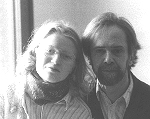General
by Kai PihlThe purpose of this text

Collecting together all the information, learned us more about music, mathematics, electronics, computers, programming and physics than we ever believed.
This text is intended to find it's place among the official manuals from Creative Labs, Inc as well as the specifications from E-mu Sytems, Inc. I hope the article will become to help an ordinary AWE-owner in the beginning of his/hers acquaintance with the card and the SoundFonts. During the short life of this article I have received lots of positive feedback. Thanks for it! I understand now that many of you wait the latter parts of my article to be written. I hope that it becomes true during this year - 1998.
You may already noticed that I'm calling the SoundBlaster soundcards merely an AWE. This doesn't mean that my text wouldn't apply to the SB32. In that ancient time we got our AWE there wasn't any other models. And now there is AWE64 and AWE64 Gold! I'm going to include a special section for them. In the future, the text may extend to a deeper level of hierarchy in order to bring out a more detailed discussion (what is already happened).
Today a big part of the questions made about AWE concern the difficulties when using the AWE and accompanied software on different platforms and with different operating systems. I can not help in those questions because I have decided to stay in Windows 3.1x for a while. This may seem to be a drawback, but if there's no other need to use 32-bit technology, the AWE-environment doesn't suppose it. (AWE64 needs a Pentium.)
We bought our AWE in november '94 right after it was released here in Finland.
I was absolutely ingorant of digital sound processing and synthetizers, even of soundcards. Fortunately I had also played violin in my early life and remembered something about music. My wife used a computer first time in her life a half year before the purchase. On the other hand, I had used computers for years and knew something about electronics too.
I was working that time for a small company programming their sales supervising software. There was a huge Canon copier with all those amazing characteristics which they nowadays have: zooming, etc. In the city library I found books that were otherways almost impossible to get or too expensive for our budget to buy. During that winter I copied twenty-two books concerning MIDI, synths, sampling and music. Those copies are now in our bookshelf and I must say that without them we could never be in the situation we now are: Happy with our AWE.
On the software side we already had Finale from Coda Music Technology. My wife used it for her notations. However, Finale is not MIDI oriented at all. Changing from notation to MIDI is like changing from word processing to desktop publishing. But let's start. There we sat in our kitchen drinking coffee and checking out the contents of the brand new AWE-package. Included was also a microphone and seven small booklets. But before we get into those... I want to thank my wife, Elina, for her patience and taking care of me during these years. I hope she has strength enough to be able to bear me, a foolish computer enthusiast.Inportance of knowledge
Next: Installing the AWE32
To: The Contents